- Heddels
- Posts
- March 5 - Champion History
March 5 - Champion History
Champion Apparel – Looking Back On a Century of Sweats
The humble sweatshirt may appear as an everyman garment, but its origins were anything but. Have a look at a hundred years of Champion Apparel.
Albert Muzquiz

Champion turned 100 in 2019, leaving in its historical wake an intriguing tale of fashion, class, and American athleticism. Champion first democratized by leaving the nation’s most elite college campuses and becoming a bona fide streetwear staple.
But the company, both contesting and profiting on their brand’s newfound ubiquity, has since covered every piece of land in the clothing landscape from mass-produced garbage to the high-end world of exclusive collaborations with the likes of Supreme, Rick Owns, and many others. Stick with us as we cover the classic athletic sweat as it became something much, much more.
The Beginning

Images via Champion.
The Feinbloom brothers founded The Knickerbocker Knitting Company in 1919 (not to be confused with Knickerbocker Mfg.), an excellent time to get into the sportswear business. The 1920s saw a boom in sports appreciation and athletic competition worldwide.
America’s colleges were the cradle of these rapidly professionalizing sports. The nation’s wealthiest and most fortunate sons and daughters squared up on fields and courts and inevitably sweat through their clothes.

Vintage Champion Sweatshirt. Image via Ebay.
Knickerbocker’s first major success was an agreement to make sweatshirts for the University of Michigan’s various sports teams. The brand was suddenly involved in the first major push to regulate sports team uniforms, which up until this point had been rather haphazardly assembled. In 1930, the company renamed itself Champion Knitting Mills.

Image via The Hut
But giving uniformity to uniforms wasn’t Champion’s only claim to fame. Industrial washing machines were shrinking and warping the team’s cotton gear, so the folks at Champion set to work, ultimately producing the now-famous “reverse-weave” sweatshirts. Reverse-weave knits are made of heavy-duty cotton fleece and are cut on the cross-grain, a deceptively simple way to prevent vertical shrinkage. At this point, athletic wear was exclusively made of cotton, a marked departure from an earlier era when almost all athletic wear (even swimsuits) was made from wool.
This era also saw the creation of hoodies, although, at that time, Champion called them “side-line sweatshirts.” Elasticated cuffs and waists were added to crew-necks to retain precious body heat and suddenly the modern sweatshirt was created.
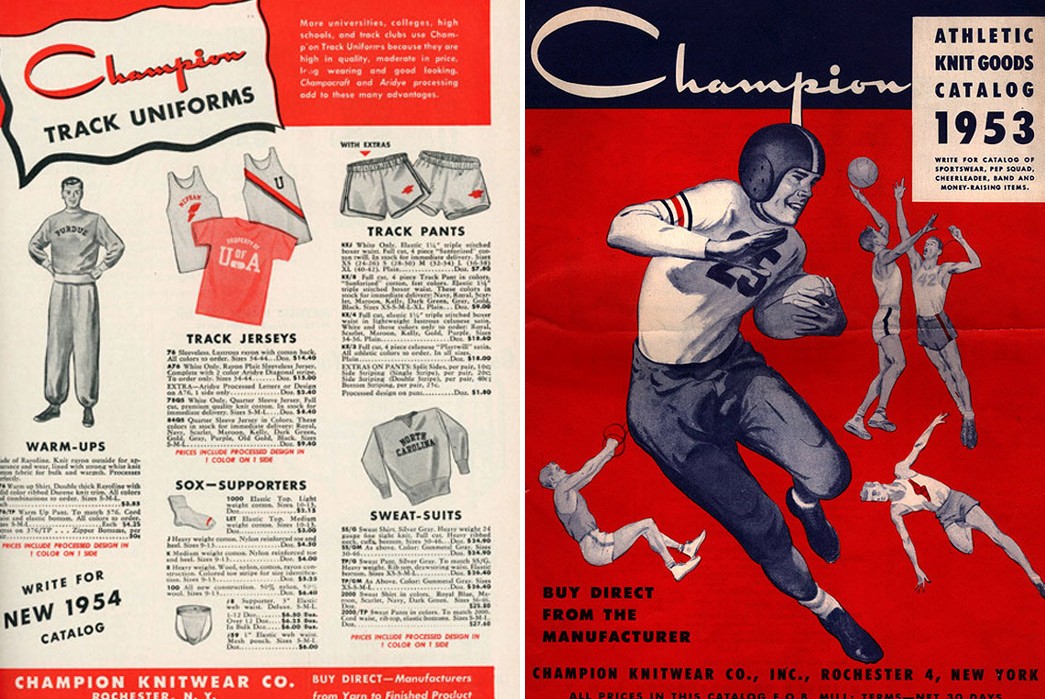
Images via Sneakers Magazine and Size
Champion Graduates
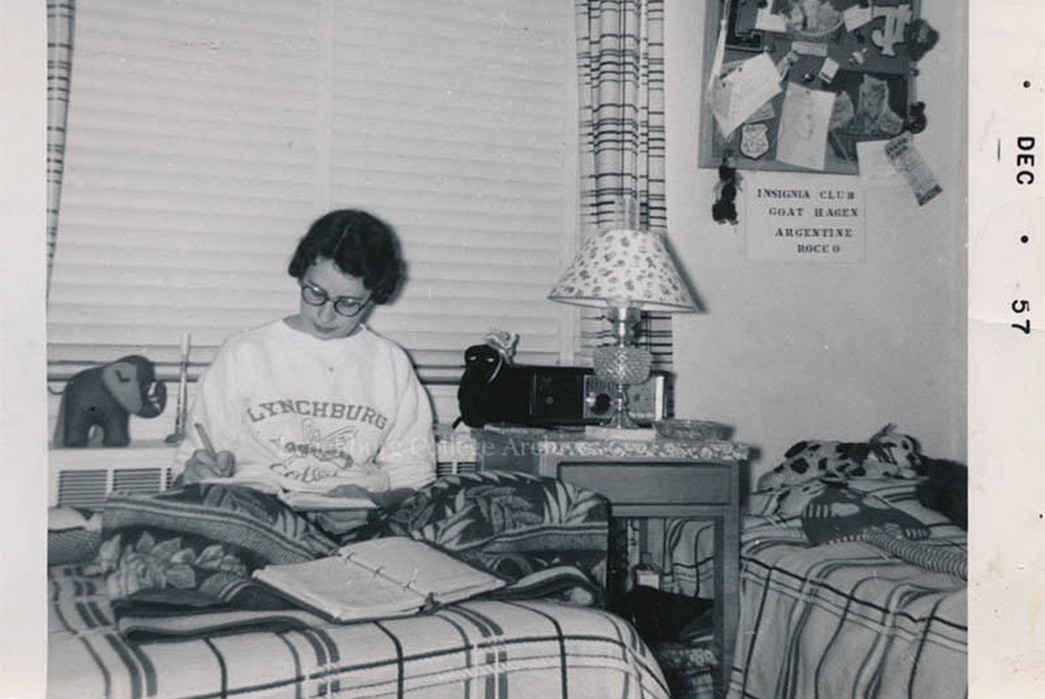
Woman Studying in a collegiate sweatshirt most likely produced by Champion. Image via Fiveprime.
Sweatshirts were slowly adopted by the non-athletes on college campuses as well. Champion was carried by many college bookstores nationwide and its warm, no-fuss clothes were a hit. But sweats were still worn almost exclusively by the country’s academics. It would take a war to bring sweatshirts to a wider audience.
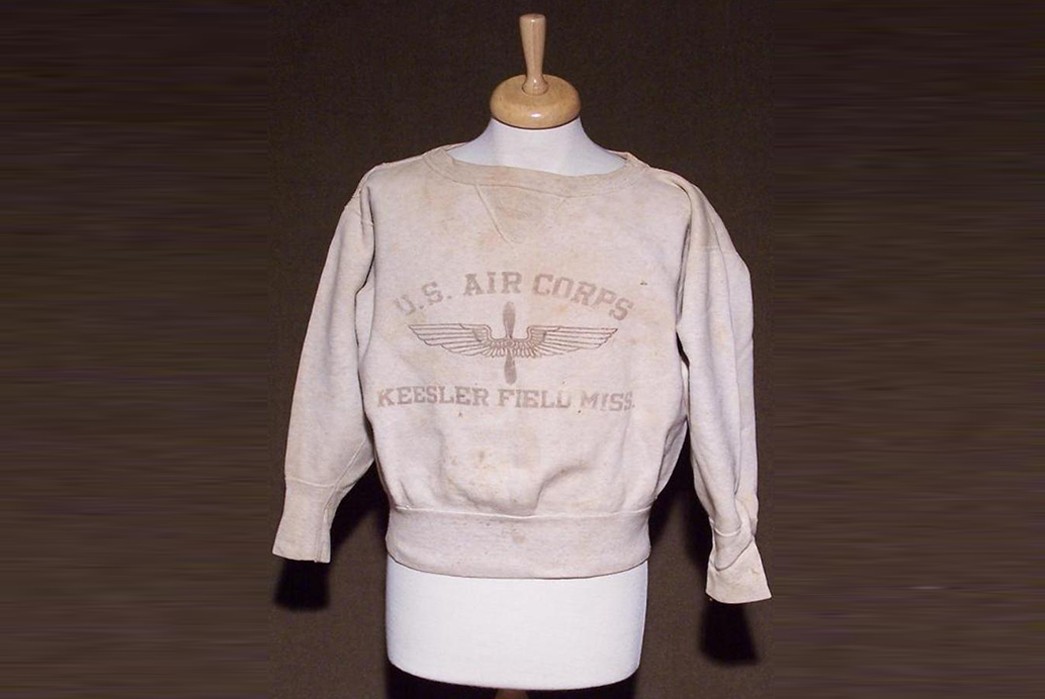
Military Sweats.
The US Army in the 40s and 50s was on the prowl for new kinds of athletic wear to train its recruits. For the first time, sweatshirts were worn on a large scale off-campus, at which point they became less an Ivy League affectation and more a crucial wardrobe staple.
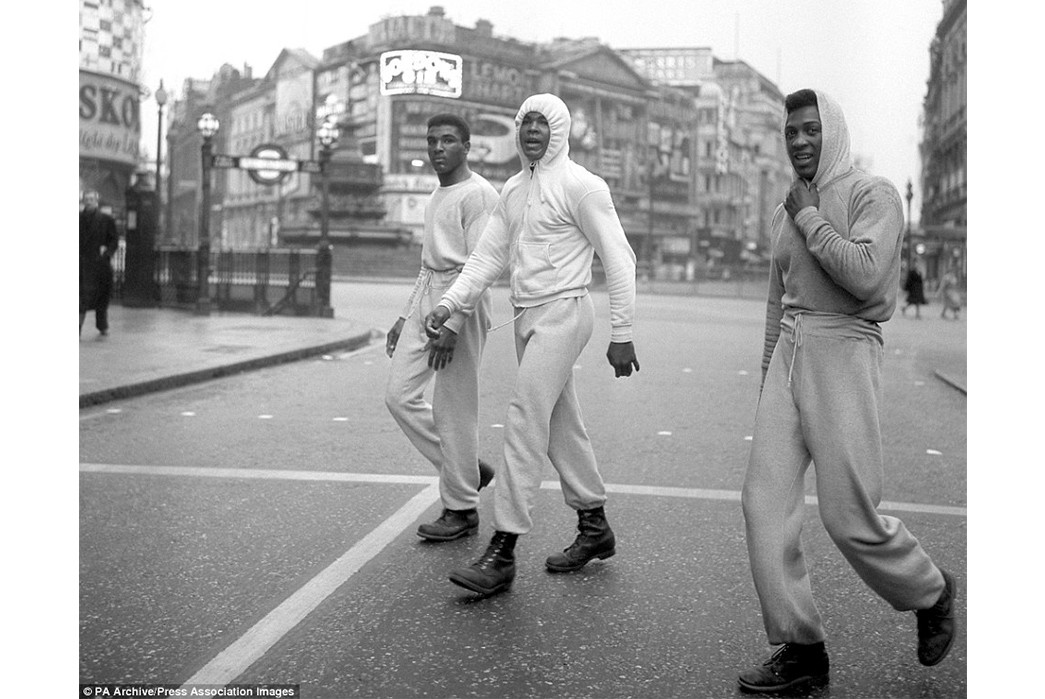
Muhammad Ali trains in London. Image via Daily Mail.
Iconic athletes were spotted in the sweats first invented by Champion, like the above photo of Muhammad Ali, training for his fight at Wembley Stadium in 1963. His iconic gear would soon be outdated, as Champion led the charge in developing new synthetic fabrics more suitable for exercise. Breathable mesh shorts, nylon-lined jackets, and sports bras were all invented in the late 1960s and reflected both recent technological advancements and the further professionalization of sports in America.
Sportswear, including Champion gear, also became associated with a brand-new genre of superstar: the hip-hop artist. The revolutionary new wave of music that began in New York would become inextricably tied to the Champion sweatshirt. This new sound gave a much-needed dose of contemporary edge to an icon in need of some reinvention.
“Champion gear that I rock, you get your boots knocked” – Raekwon
“A rugged vet, durable like a Champion sweat” – Method Man
“Ghetto roots, tree on my boots, my kicks vary. I rep truth, Champion sweatsuits” – Nas

Young Jay Z (left) and Ghostface Killah (right) wearing Champion sweatshirts. Images via Pinterest and Reddit.
In the 1990s, Champion scored another victory: the exclusive right to outfit the 27 teams of the NBA. But Champion also made a name for itself on the international scale at the 1990 Olympics in Barcelona, providing the uniforms for the gold medal-winning American “dream team.” The 90s marked an important moment for Champion. Global Brand Ambassador Manny Martinez reminisces that, “you didn’t even have to put it on racks back then.” A perfect storm of cool kept Champion on the cutting edge, but no one was calling their stuff high-end exactly. That all came later.

Images via Britannica and USAB.
Champion x (Insert Expensive Brand Here)
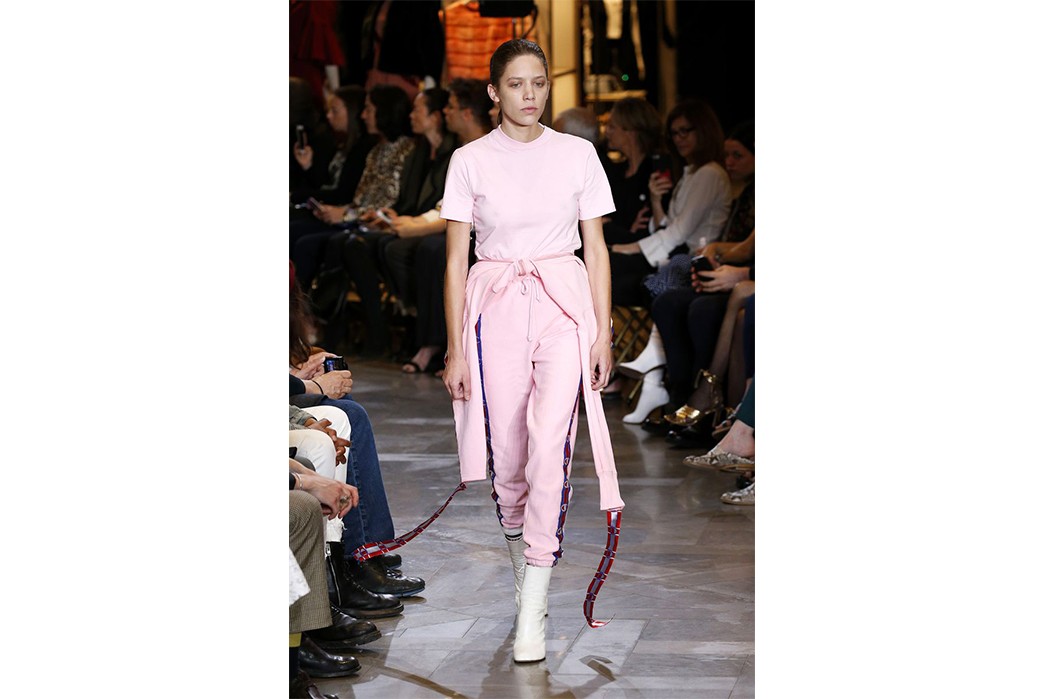
Vetements gets all Vetements with the Champion brand. Image via Racked.
In the last decade, fashion and streetwear labels like Vetements and Supreme have collaborated with Champion to create high-priced logo repositories like the above ensemble. While the designs are (at least to this snobby author) questionable at best, the designers who make them have intriguing reasons for their love of the iconic athletic brand.
Many of the most influential players in fashion today grew up in Champion, in the era where high school gym uniforms bore the brand’s iconic C logo. So although these collaborations are prohibitively priced, they (at least conceptually) maintain some of their everyman quality. The proverbial ” blank slate” is frequently mentioned.
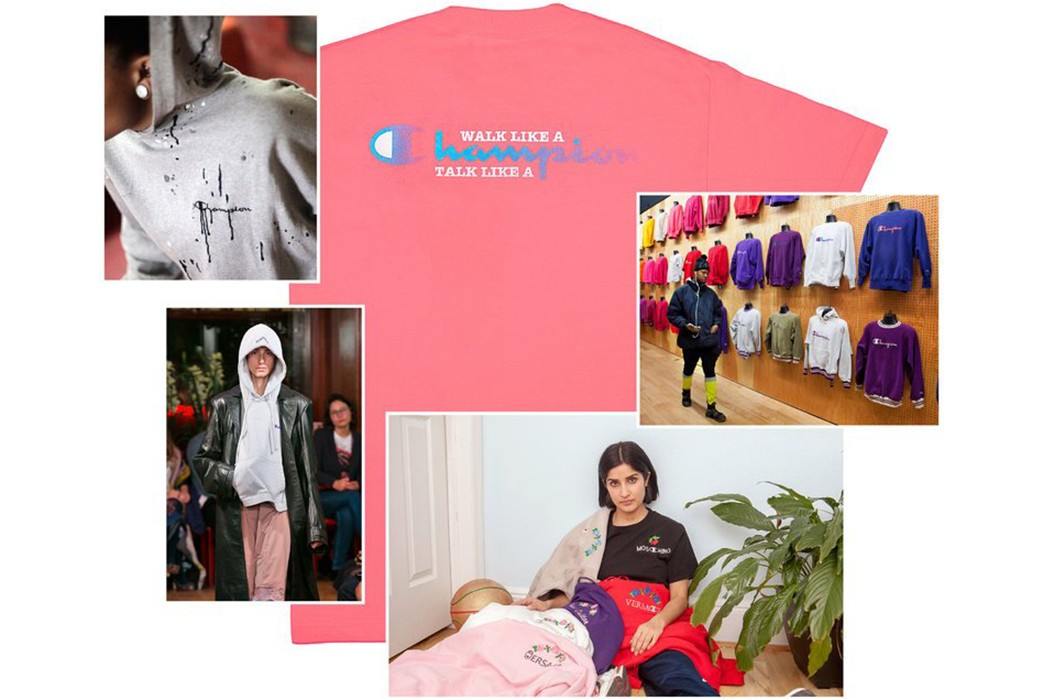
Champion is fancy now! Image via the NY Times.
Regardless of the hype factor, Champion could not be as successful as it is today without remaining relevant. Its ties to old-timey athleticism keep it a classic basic with the retro-crowd and its ascendancy in the NBA and the early days of hip-hop has infused the brand with a dose of 90s nostalgia. The hype collabs thrust Champion into the popular zeitgeist and paved the way for dozens of other, more down-to-earth collabs. Partnering with Peanuts, Percival menswear, Todd Snyder, Beams Plus, Beastie Boys, WTAPS, and more, Champion has made its mark in many corners of the fashion world. The diverse list of collaborators only shows how ubiquitous Champion is.
Although the sweatshirt is remarkably less elitist and white-washed than in its early days on the University of Michigan, there remains a marked dichotomy in the treatment of its wearers. While Mark Zuckerberg was met with bemusement by venture capitalist investors when he arrived at a meeting in a hoodie, teenager Trayvon Martin was gunned down by George Zimmerman in Sanford, Florida in essentially the same outfit. In shocking ways, the sweatshirt is interpreted variably as a sign of cheeky rebellion or delinquency, often dependent on the wearer’s race.
Champion Today

Champion on Broadway. Image via Champion.
After over 100 years, we can be pretty sure that Champion will be sticking around, but what remains to be seen is the way the company will continue to cling to relevance. Their brand history is fascinating in the way it bounces across race and class lines and even into the world of high fashion. Whether or not this cultural ping pong game continues is immaterial to the brand’s success. The blank slate, with or without extra bells and whistles is here to stay.

Cheap-o Champion via Look Again and Sports Direct
Quality is something that is a huge issue in the world of Champion and if you’re reading this, quality clothes are probably your thing. A quick Google will pull up dozens of cheaply made Champion goods – polyester blend sweatshirts (like the above image) and thin t-shirts that focus on branding over quality or fit, littering the virtual shelves of Amazon and sporting goods websites. The global presence of Champion has left the brand with numerous factions with different aims and markets, which can make it hard to know where to find the best quality options.
The good news is that Reverse Weave Champion gear is still produced today and that the brand is pretty committed to keeping their historical sweatshirts alive. Champion has 38 brick-and-mortar stores in the USA, with Reverse Weave options available in most of them. The quality isn’t the same as back in the mid-20th century — most are blended with a portion of polyester and made in Cambodia/Honduras at the time of writing — but they’re still good value for money.
Champion will sporadically produce a Made in USA line, and the Japanese market tends to receive a lot of it. This makes sense due to Japan’s fascination with historical American clothing, and many of the designs available in Japan have vintage/reproduction collegiate or military prints. Legendary Japanese denim store, Hinoya, stocks a range of Champion Reverse Weave, including MiUSA options:
Champion MADE IN USA Reverse Weave Crew Neck – YALE – C5-A004, available for $195 from HINOYA.
Champion C3-A216 Reverse Weave Sweat Pants (made in Cambodia) available for $96 from HINOYA.
Champion Japan Reverse Weave Hooded Sweatshirt USAF (made in Cambodia) available for $115 from HINOYA.

Champion Japan Reverse Weave Crew Neck USAFA (made in Cambodia) available for $105 from HINOYA.
Gallery

Mid-century Champion catalogs via Internet Archive and Football Archaeology

1970s Champion Nylon Mesh Shorts and Coaches Jacket via eBay and Depop respectively.

1969 Champion catalog via Worthpoint

1969 Champion catalog via Worthpoint
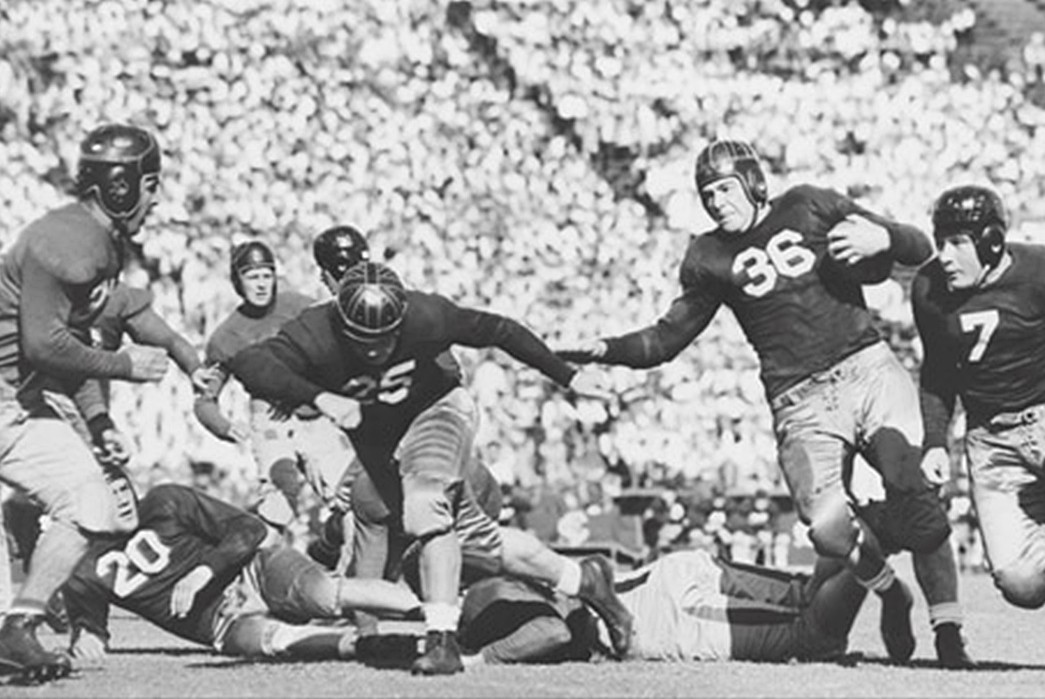
Champion football uniforms. Image via Champion.

Mid-century Champion catalogs via Football Archaeology
Like this? Read these:
What did you think of today's newsletter? |





